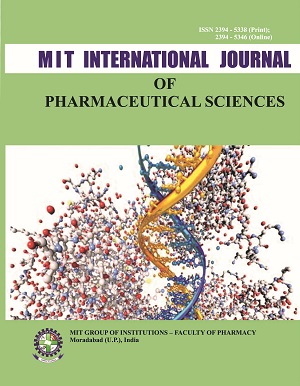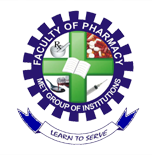
MIT INTERNATIONAL JOURNAL OF PHARMACEUTICAL SCIENCES (MITIJPS)
ISSN 2394-5338 (Print); 2394-5346 (Online)
Volume 7, Issue 2, 2022
This is open access Journal
Global Impact factor:0.565
SJIF Impact factor: 5.296
MITIJPS
Volume 4, Issue 2, 2018
Original Article
Simultaneous spectrophotometric estimation of Camylofin Dihydrochloride and Diclofenac Potassium in tablet dosage form
Sujit Patil*, Manisha Khaire, Sachin S. Rane, Rajesh Y. Choudhari, Sachin Fegade
aDepartment of Pharmaceutical Chemistry T V E S College of Pharmacy, Faizpur, Jalgaon, Maharashtra, India.
bJ V P M Rasiklal Manikchand Dhariwal College of Pharmacy, Chinchwad, Pune, Maharashtra, India.
*Corresponding Author: Tel.: +91 9673355771, E-mail: sujitpatil1887@gmail.com
Abstract
The accurate, precise, sensitive and economical spectrophotometric method was developed and validated for simultaneous estimation of Camylofin Dihydrochloride and Diclofenac Potassium tablet dosage form. The method employed for UV estimation was simultaneous equation method. The method employs 248 nm as λ1 and 280 nm as λ2 for formation of equations. Camylofin Dihydrochloride and Diclofenac Potassium obeys Beer’s law in the concentration range 5-80 μg/mL (r2 = 0.998) and 5-80 μg/mL (r2 = 0.997). The mean recovery for Camylofin Dihydrochloride and Diclofenac Potassium, were found to be 99.652 ±0.2129% and 99.80 ±0.0.00307% respectively. The developed method were validated according to ICH guidelines and values of accuracy, precision and other statistical analysis were found to be in good accordance with the prescribed values. Thus, the proposed methods were successfully applied for simultaneous determination of Camylofin Dihydrochloride and Diclofenac Potassium, routine analytical work.
Keywords: Camylofin Dihydrochloride, Diclofenac Potassium, Validation, Simultaneous equation method
Original Article
Spectrophotometric determination of pKa of Montelukast sodium
Vaishali*, Vikas Kumar Singh
aMoradabad Educational Trust Group of Institutions, Faculty of Pharmacy, Moradabad-244001, Uttar Pradesh, India.
*Corresponding Author: Tel.: +91 9997817454, E-mail: vaishalihi009@gmail.com
Abstract
The value of the acid dissociation constant (pKa) is an important parameter that indicates the degree of ionization of molecules in solution at different pH values. The pKa of Montelukast Sodium were determined by spectrophotometrically by absorbance measurements at different pH values in the wavelength range between 200 and 400 nm. The pKa1 of Montelukast Sodium was found to be 3.3 and pKa2 of Montelukast Sodium was found to be 4.4. Two graphical methods were used to estimate the acid dissociation constant (pKa) using absorbance measurements. The equation for the dependence of the absorbance on pH at λ = 336nm and 373nm was used for pKa1 determination and for pKa2 absorbance on pH at λ = 284nm and 351nm was used for obtaining calibration curves.The literature contains no previous reports of the pKa by Spectrophotometric method. This spectroscopic method is simple, rapid, accurate, precise and low cost for quality controls of commercial pharmaceutical dosage forms.
Keywords: Montelukast sodium, Active pharmaceutical ingredient, Design of Buffers, Spectrophotometric Titration, Determination of pKa
Original Article
Gallic acid and flavonoids of Amaranthus retroflexus
G. Jyoti Jaina,*, S. Ramachandra Settyb
bDepartment of Pharmacology, Luqman College of Pharmacy, Gulbarga, Karnataka, India.
bDepartment of Pharmacology, Govt. College of Pharmacy, Bangalore, Karnataka, India.
*Corresponding Author: Tel.: +91 9342660391, E-mail: jyotilcp2@gmail.com
Abstract
Amaranthus retroflexus is a medicinal plant. Our aim was to investigate its in-vitro antioxidant properties. Therefore, 70% ethanolic extract of Amaranthus retroflexus leaves (AREE) and direct exhaustive extracts were taken. The parameter studied were gallic acid and total flavonoidal activities. In-vitro models were carried out to evaluate its antioxidant activities. Therefore these results concluded that, the ethanolic and cold water extracts afford significant antioxidant activities which may be attributed due to polyphenols.
Keywords: Amaranthus retroflexus, Gallic acid, Total flavonoids, Polyphenols
Review Article
Biomarkers for heart failure
Muhammad Imran Qadira,*, Sobia Yousafb
Institute of Molecular Biology & Biotechnology, Bahauddin Zakariya University, Multan, Pakistan.
College of Pharmacy, G.C. University, Faisalabad, Pakistan
*Corresponding Author: Tel.: +92 3016515613, E-mail: mrimranqadir@hotmail.com
Abstract
The increasing rate of heart failure poses a lot of problems for health care system worldwide. Heart failure sign and symptoms depend upon the part which is being altered. Left side heart failure has different symptoms while right side failure shows different symptoms. Different classes of heart failure have been categorized depending upon different factors the most important one is functional classification. This classification is not reproducible hence four stages of heart failure has been defined. Before its worsening, heart failure can be predicted by using some natural substances in body due to altered conditions that act as marker of the disease. These substances are called biomarkers. These biomarkers may be divided into different seven categories including inflammatory products, elevated reactive oxygen species, heart remodeling products, and excessive collagen synthesis stimulants, myocardial cell injury products, neurohormones and cardiac stress biomarkers.
Keywords: Heart failure, Biomarkers
Review Article
Organs-on-Chips : Innovation to new testing technology research and discovery
Aaisha Kazi*, Monika Patil, Anand Kakde, Manisha Khaire
aRasiklal M. Dhariwal Institute of Pharmaceutical Education and Research Chinchwad, Pune, Maharashtra, India.
bRasiklal M. Dhariwal, College of Pharmacy, Chinchwad, Pune, Maharashtra, India.
*Corresponding Author: Tel.: +91 8087696050, E-mail: aaishakhazi59@gmail.com
Abstract
Since the last few years, many recent advances in biomedical research are related to the combination of biology and micro engineering. Micro engineering now enables the incorporation of small devices into 3-D culture models to reproduce the complex micro-environment of the modelled organ, often referred to as organson-a-chip (OoCs). This review describes history of organ chip, application and various OoCs developed to mimic liver, brain, kidney, lung tissues.
Keywords: Organ chip, Cell structure, Clinical studies, In-vitro, OOC Design
Review Article
Solid dispersion a promising tool for drug solubility improvement
Dharmendra Solanki
Institute of Pharmacy, Dr. A.P.J. Abdul Kalam University, Indore, Madhya Pradesh, India.
*Corresponding Author: Tel.: +91 9977738448, E-mail: dharmendrasolanki29@gmail.com
Abstract
The term solid dispersion refers to a group of solid products consisting of at least two different components, generally a hydrophilic matrix and hydrophobic drugs. The matrix can be either crystalline or amorphous. The drug can be dispersed molecularly, in amorphous particles or in crystalline particles. The formation of solid dispersion is a useful approach to enhance the dissolution rate of sparingly soluble drugs. The dissolution behavior is mostly affected, if the drug is present in the amorphous state or even dissolved in the carrier. However, such systems may be metastable and they tend to return to a more stable state, which can result in the recrystallization of the drugs. The different types of solid dispersions based on the molecular arrangement have been highlighted. Some of the practical aspects to be considered for the preparation of solid dispersions, such as selection of carrier and methods of physicochemical characterization are discussed. The development of solid dispersion as a practically viable method to enhance bioavailability of poorly water –soluble drugs overcome the limitation of previous approaches such as salt formation, solubilization by cosolvents, and particle size reduction.
Keywords: Solid dispersion, Poorly soluble drugs, Hydrophilic, Matrix system, Bioavailability
Review Article
Applications of nanoparticles in anticancer therapeutics
Shruti Rayan*, Rajat Batra
SVKM’S Narsee Monjee Institute of Management Studies, Shobhaben Pratapbhai Patel School of Pharmacy & Technology Management, Vile Parle (W), Mumbai, India.
*Corresponding Author: Tel.: +91 7387460700, E-mail: shruti.nmimssptm2019@gmail.com
Abstract
The utilization of nanotechnology is done to overcome the conventional strategies which were utilized to treat growth. The objective of restorative operators utilized as a part of growth treatment goes for constraining the quick partitioning cells, to stop or breaking point their augmentation and to advance apoptosis. Traditional techniques were not ready to recognize the right means because of which the treatment was not valuable and unfriendly impacts were noted. Nanotechnology beats this variable as it intends to focus on a specific organ or tissue and the conveyance of the medication is additionally done in a constraining way and at a focused in the vicinity, these aides in maintaining a strategic distance from or restricting the systemic lethality and accordingly increment the bioavailability and profile record of the medication. The upside of utilizing nanoparticles as a medication transporters is that they have awesome restricting limit and turn around multidrug resistance property. The present survey gets the consideration on the pathophysiology of the growth, the different sorts of nanoparticles utilized as a part of medication conveyance, the different sub-atomic components which can separate the malignancy cells from the ordinary ones and finally the uses of the nanoparticles in helpful medication conveyance framework.
Keywords: Cancer, Nanotechnology, Nanoparticles, Types of nanoparticles, Applications
Review Article
Needle free injection device: The painless technology
Aaisha Kazi*, Anand P. Kakde, Manisha P. Khaire, Priyanka N. Chhajed
Rasiklal M. Dhariwal Institute of Pharmaceutical Education and Research Chinchwad, Pune, Maharashtra, India.
*Corresponding Author: Tel.: +91 8087696050, E-mail: aaishakazi59@gmail.com
Abstract
Today there are readily developing technologies that promise to make the administration of medicine more efficient and less painful. Needle free- injection device are injections developed to be patient oriented, easy to use, disposable and their use is expected to increase considerably. It solves the problems created due to conventional needles making them safer, less expensive, and much more convenient for medication purpose. Needle free injection gives very effective injections for wide range of drugs and is bioequivalent to syringe and needle, results in less pain, and is strongly preferred by patients. Basically the aim of modern needle-free drug delivery system is to enhance the prescribing and adoption of important drugs that require self-injection.
Keywords: DNA-Based, Powder Injection, Intramuscular, Pulse Micro jet
